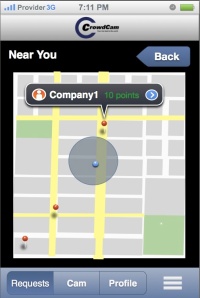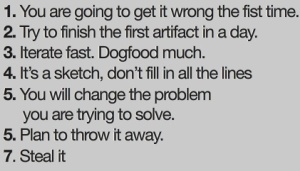Solving the Right Problem
by Jason Spingarn-Koff
Assignment 1 for the Knight-Mozzilla Learning Lab
I’ve been thinking a lot about this bit of wisdom from Aza Raskin’s lecture: Most of design is finding the right problem to solve. He recounted the story of Paul MacCready, who won a longstanding airplane engineering competition by reframing the design problem: he shifted his focus from building a complex machine to building one that could be repaired quickly. As Aza later summarized, “It’s not about thinking outside the box, but finding the right box to think inside.”
This resonates strongly for me and my project, CrowdCam — a crowd-sourced mobile platform to provide live video news feeds from virtually anywhere, at any time. In recent months, I’ve begun building basic interactive GUI mock-ups of the full system (an iPhone app and Website). I’ve labored intensely over every screen, menu, and icon. Adding hotlinks, I’ve simulated the interaction flow. Though rough, it’s pretty exciting, and I can’t wait to work with engineers on building the full prototype.
At the same time, I’ve been seeking feedback from media executives, cyberlaw scholars, civic media mavens, and technology entrepreneurs. The recent MIT Knight Civic Media Conference was especially helpful. People generally love the idea. There seems to be a real need and niche for a system such as CrowdCam. Yet I’ve also been hearing a consistent line of questioning that isn’t so easy to answer. How large a network of registered “Cams” (people with video-enabled cellphone cameras) do I need? And how will I sign up all these people? Will people in remote areas, even war zones, have the right technology? If so, what would prompt them to download the app and register?
These questions underline a troubling possibility: What if I build the most beautiful, elegant system — yet not enough people use it? Without scale, the platform will be useless. It’s one thing to build a technology; it’s quite another thing to build a community of users.
So now I’m wondering if my principal design problem is not: “build the best platform for mobile live streaming and 2-way communication to newsrooms” (even though that is of course a key component). Like Paul McReady, I may need to shift focus from building a complex machine to solving an underlying process. The new problem statement might be: “how to find people anywhere in the world, fast.” Can I use existing technologies? Piggyback onto existing communities?
Looking over Aza’s slide of his top 7 design tips, #5 seems right on: “You will change the problem you are trying to solve.” Though as I click through my proud mock-ups, I’m not quite ready to embrace #7: “Plan to throw it away.”


How did I miss CrowdCam during my first scouting round through the submissions? It’s a great concept and one that has been proven effective in other domains. As a fellow #MozNewsLab hacker, I can help put together the prototype. In fact, I’m almost finishing another mobile app that relies heavily on location… JQuery Mobile + Google Maps. We should find sometime later this week to chat about your plans. I have my own project going but plenty of cycles to help others too.
I like the CrowdCam idea as well. This is going to sound silly but how does one control what one films live? I worry it might get filthy images-wise like Chatroulette did at one time. But I guess those terrible videos can be marked for delete by the public, like comments. Strong idea. Amy.
You can learn about the available “Cams” to make an informed choice for who to use. Reputation profiles are an important part of the system to encourage quality and journalistic utility. Chat roulette’s problem is it’s random and lacks a marketplace and reputation system.
Good post.
“In recent months, I’ve begun building basic interactive GUI mock-ups of the full system (an iPhone app and Website). ”
Let’s see ’em! 🙂
Phillip.
[…] Jason Spingarn-Koff ‘s Crowdcam project addresses the necessity for free-flowing information through networks of video-enabled cellphone cameras. Through on the ground “Cam” operators, news organizations around the world can access raw footage to supplement their own reporters’ analyses. "Socializing the news" by Laura Hilliger […]
Great project! Similar to one we’ve been playing with. We started out in a similar place, with a focus on live streaming. After bouncing the project around we started playing more with the importance of archiving content in time and space. Takes a ‘breaking news’ paradigm and shifts it to one where you’re enabling recreation of events.
Demo is here (gets interesting at 47s):
http://www.mysix.com/theidea/timemap/
Happy to chat more.
Hi, I would love to talk to you about field tests for your project, especially since you say finding the users is a big challenge. I am a News Challenge 2007 winner for my org Video Volunteers. I was also at the Knight conf this year at MIT but I don’t think we met.
We have 100+ people in slums and villages across India who work with us as video news reporters. We’re trying to find someone to partner with to see how they can stream video from their villages. You seem ideal. Can you you email me at jessica@videovolunteers.org?
[…] Filmmaker and journalist Jason Spingarn-Koff offered a glimpse into crowd-powered video feeds. […]